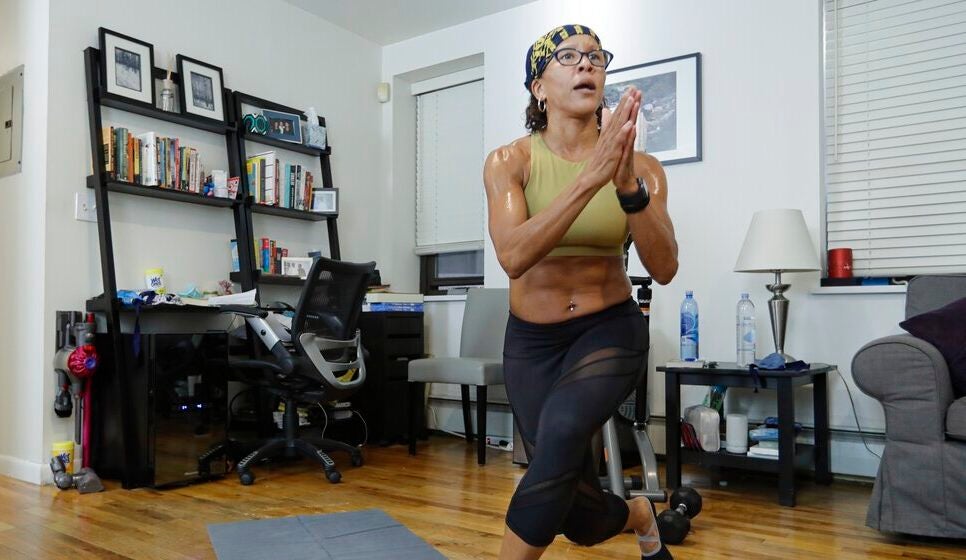Physical therapist Andrew Starsky said he’s been hearing complaints more frequently about aches and pains caused by improvised work-from-home setups.
Many of those complaints are coming from his own students.
Starsky is a clinical associate professor in the Department of Physical Therapy at Marquette University and said his students, who oscillate between the classroom and at-home learning, are feeling the effects of non-ergonomic work stations.
News with a little more humanity
WPR’s “Wisconsin Today” newsletter keeps you connected to the state you love without feeling overwhelmed. No paywall. No agenda. No corporate filter.
“We have to remind them of some of the basics,” he said before diving into some simple examples that can help relieve pressure and pain as people find ways to make their work from home spaces more comfortable.
Neck And Head
Strain on our heads and neck can be caused by constantly looking down at our monitors, Starksy said. To correct this, first figure out which direction your eyes are gazing.
If you’re sitting up straight with your feet on the floor and your back relatively straight, what are your eyes looking at? If you’re facing straight ahead, your eyes should be resting on the top of your computer screen. If they’re not, take action to correct that, maybe by putting your monitor atop a box or a stack of books.
Tip No. 1: Elevate your computer screens so that you’re not having to slouch or hunch over to look down at them.
Additionally, help prevent eye strain by following the 20-20-20 rule, Starsky said. The 20-20-20 rules consists of looking away from your computer every 20 minutes for at least 20 seconds at something 20 feet away.
Shoulders
Where are your shoulders? If you notice that they’re pulled forward, pull them back a bit. If they’re shrugged up, pull them down, Starsky said.
If we keep our shoulders shrugged up or shifted forward, that means we’re using muscles unnecessarily.
Starsky said that we can sustain a low level muscle contraction for about 10 minutes before fatigue starts to set in and other muscles jump in to compensate.
“You can sustain these contractions for maybe 10 minutes at a time, which tells us that maybe every 10 minutes or so, we should be shifting positions just a little,” he said.
Tip No. 2: Sit up tall with your feet flat on the floor. Focus on getting your elbows behind you. Starksy said you can think about this like trying to put your elbows into your back pockets.
He said squeezing your elbows behind you toward your back pockets will give you an idea of where your shoulders should be.
Then, he said, compare where they should be to where they normally are. If they move more than an inch or so, then you’ll need to remind yourself once in a while to move your shoulders back.
Low Back
Your lumbar spine should have a gentle curvature, something that physical therapists refer to as a lordosis.
What can help exercise and stretch the lower back, he said, is pelvic tilting.
Tip No. 3: Sitting, with your feet flat on the floor, try to roll your butt backwards, which has the effect of reversing the curve of the spine. Then, try rolling the butt or hips forward, which enhances the curve of the spine.
“This pelvic tilt is something that you could be doing even while you’re typing,” he said. “It takes sitting and makes it into a much more active process.”
Muscle Tension
Starsky said it’s common for people to have specific muscle groups that tend to hyper activate when stressed, for example the jaw or shoulders.
He said giving yourself some sort of clue or reminder to release tension in those spots is key. One way to do that is set a timer on your phone that will ding every 10 minutes.
Another helpful way to relieve tension is by leaning your sore muscle into a tennis or lacrosse ball. That pressure application will help relieve the tension.
Tip No. 4: With your feet flat on the floor, sit on your left hand to anchor your left shoulder. Then, gently place your right hand across the top of your head and pull so that your right ear moves toward your right shoulder. Hold that stretch for about 20 seconds. Then, switch positions and repeat the exercise.
“If you’re going to do any kind of stretching, keep it pretty gentle,” Starsky said. “If you overstretch, what you’ll actually do is trigger that muscle to go into more of a protective mode where it’s going to tighten up again.”
Wisconsin Public Radio, © Copyright 2025, Board of Regents of the University of Wisconsin System and Wisconsin Educational Communications Board.







